
Asthma Inhaler Shrinks to Credit Card Size in New Design

People suffering from asthma may soon have a sleek alternative to traditional — and bulky — inhalers.
The Bloom Inhaler fits in the palm of your hand, and is approximately the size and shape of a credit card. Asthma medication is delivered through a tiny nozzle that flips into place atop a circular hole in the top half of the device; users place their mouths over the hole to administer a dose of medicine, just as they would when using a traditional inhaler's mouthpiece.
Any standard inhaler canister can be used to fill Bloom, the product website said. The device holds six doses, each dispensed with the push of a trigger, and can be refilled an infinite number of times. The flat, steel inhaler fits easily inside a wallet, and its trim design allows users to carry and use the device discreetly, unlike bulkier models that can be awkward to carry. [11 Surprising Facts About the Immune System]
This slender gadget is one of 20 designs vying to be selected as the International Winner for the James Dyson Award 2016. The annual competition challenges participants to produce creative solutions to real-world problems, and celebrates excellence and inventiveness in design engineering.
Student designers from around the world submitted more than 1,000 projects; 20 were selected for the Dyson Engineers Shortlist, the James Dyson Foundation announced today (Sept. 29) on the organization's website.
Of those 20 submissions, one International Winner will be picked by inventor and designer Sir James Dyson, to be announced on Oct. 27. The winner will receive an award of $45,000, and an additional $7,500 will go to the inventor's university.
Bloom's creator, James Cazzoli, is a mechanical engineering student at Rensselaer Polytechnic Institute in New York. Cazzoli said he drew inspiration for this particular design challenge from his own experience growing up with people who suffered from severe asthma. He thought that a more streamlined inhaler design could help people with chronic asthma feel less constrained by their dependence on the medication, the inventor said in a statement.
Sign up for the Live Science daily newsletter now
Get the world’s most fascinating discoveries delivered straight to your inbox.
"I want to give some independence back to asthmatics, by redesigning the inhaler to completely defer to the user," he explained.
The name "Bloom" is a nod to the seasonal activity of blooming flowers, which can worsen asthma symptoms, Cazzoli told Live Science in an email.
"As the flowers bloom, we need to be vigilant and have rescue medication nearby when it is needed," Cazzoli said.
"However, symbolically, a blooming flower also represents hope. People who live with chronic conditions are dependent on their medication. And of course, we're trying to ease the burden of living with asthma with the Bloom Inhaler," he added.
For those with asthma who are used to wrapping their lips around an inhaler's mouthpiece, the so-called "open-mouth technique" Bloom employs — where the mouth is near the dispensing nozzle but not sealed around it — may seem awkward. However, the notion that medicine will be lost if there isn't a tight seal between the lips and a mouthpiece is a misconception, Cazzoli explained.
"Theoretically, the additional distance slows down the aerosol, allowing the droplets to be inhaled deeper into the lungs. Studies have been done to show there is no difference in drug delivery between open mouth or closed mouth techniques if the patient is well coordinated," he said.
Tests are currently underway to ensure that Bloom meets FDA medical-device requirements for safety and reliability. According to the Bloom website, the estimated cost for each device will be $40, and Bloom will begin accepting preorders pending FDA approval.
Original article on Live Science.

Mindy Weisberger is an editor at Scholastic and a former Live Science channel editor and senior writer. She has reported on general science, covering climate change, paleontology, biology and space. Mindy studied film at Columbia University; prior to Live Science she produced, wrote and directed media for the American Museum of Natural History in New York City. Her videos about dinosaurs, astrophysics, biodiversity and evolution appear in museums and science centers worldwide, earning awards such as the CINE Golden Eagle and the Communicator Award of Excellence. Her writing has also appeared in Scientific American, The Washington Post and How It Works Magazine. Her book "Rise of the Zombie Bugs: The Surprising Science of Parasitic Mind Control" will be published in spring 2025 by Johns Hopkins University Press.












